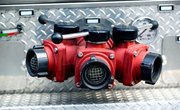
Valves are used to control the flow of gases, liquids and granular solids. They come in many types, sizes, materials, pressure and temperature ratings, and means of actuation. Gate valves and ball valves are two distinct members of the valve family, and are generally used for two different types of flow control.
Description
Gate valves have a flat closure element that slides in and out of the media stream to open or close the valve. In the bronze-body gate valves that are frequently used in commercial and residential applications, a bronze disc moves up and down to open and close the valve. The valve is designed so the brass valve stem remains at the same height relative to the valve as the disc moves. A Teflon packing held in place by a threaded bonnet prevents leaks around the stem. Manual valves are actuated by turning a cast-iron handwheel.
Ball valves have a spherical closure element with a round or other-shaped hole in it. Aligning the hole with the flow opens the valve, and placing the solid outside of the ball in the flow shuts the valve. The ball rests on a valve seat, and the stem is inserted into the top of the ball. Packing and washers around the stem prevent leakage. A handle for manual actuation is attached to the stem. Stops keep the handle from rotating more than 90 degrees.
Ports
A gate valve has two ports, an inlet and an outlet. The gate valve described above has threaded ports, although soldered and flanged connections are available.
Ball valves have two or more ports. Connections to the ports offer the same options as for the gate valve. Ball valves made with three ports are used as mixing or diverting valves.
Flow Characteristics
The flow through a partially opened gate valve is not proportional to the motion of the closure element. This limits the usability of gate valves for active control of media flows; thus, gate valves are mainly used as shutoff valves to isolate equipment or sections of pipe.
Ball valves can be designed so the flow is closely proportional to the rotation of the closure element. This is called a “modified equal percentage” flow characteristic. This makes ball valves suitable for active control of media flows.
Actuation
Gate valves are ideal for isolation of general purpose flows, as well as for high-pressure and high-temperature applications where operation is infrequent. For this reason, manual operation is typical and generally accomplished through a multi-turn handwheel assembly, although mechanical, pneumatic and electric actuators are available.
Ball valves are actuated manually, and also by electric and pneumatic actuators as parts of flow control systems. One advantage of a manually actuated ball valve over a gate valve is the handle position makes the position of the ball easy to “see.”
Cost
The differences between gate and ball valves makes a cost comparison somewhat like comparing apples and oranges. However, for bronze-body 2-inch diameter general-purpose threaded-end manually actuated valves, thevalveshop.com shows the following prices as of June 2010:
- Stockham model GV bronze gate valve, 2-inch diameter, class 150, solid disc, non-rising stem and threaded ends: $106.00
- Conbraco Apollo series 70-100, general-purpose, standard-port ball valve, bronze-body, 2-inch diameter, chrome-plated ball, and RPTFE seals: $63.17
References
About the Author
Walt Sampson has written technical manuals and corporate proposals since 1970. He has written for "The Denver Post" and "The Arizona Republic." Energy-conservation awards led to writing for professional magazines. Sampson has engineering degrees from the Naval Academy and the University of Michigan, and a Master of Christian Studies from Regent College.
